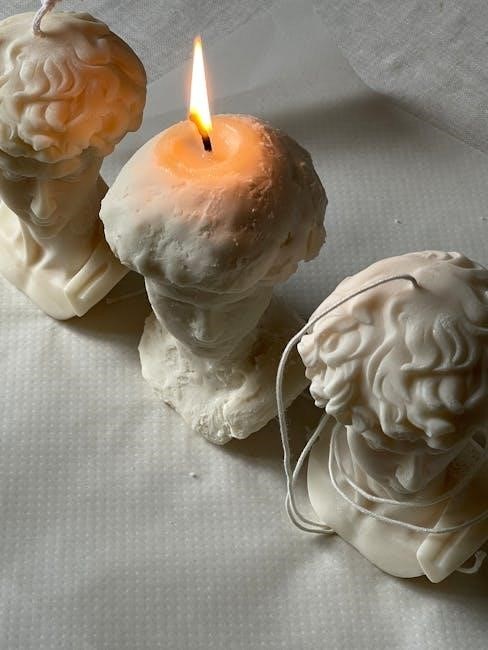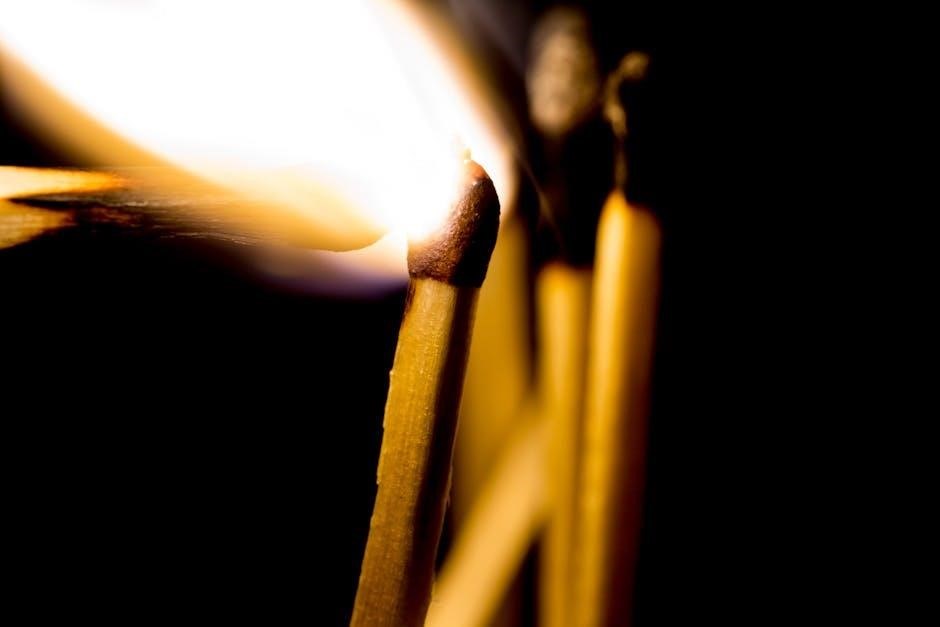Fire sprinkler heads are a critical component of fire suppression systems, available in types such as pendant, upright, and sidewall. They activate via heat-sensitive elements, releasing water to control fires. Selecting the right type ensures effective fire protection based on hazard levels and coverage needs.
Overview of Fire Sprinkler Systems
Fire sprinkler systems are automated fire protection solutions designed to detect and suppress fires in domestic and commercial settings. These systems consist of a network of pipes, sprinkler heads, and control valves. When heat from a fire activates a sprinkler head, water is released to control or extinguish the fire. Sprinkler systems are highly reliable and effective, offering dual functionality by combining fire detection and suppression capabilities. They are widely used due to their proven ability to minimize fire-related damages and ensure safety in various applications.
Importance of Sprinkler Head Types
The type of sprinkler head used significantly impacts the effectiveness of a fire suppression system. Different environments require specific sprinkler types to address varying fire hazards, such as light, ordinary, or high-risk scenarios. Proper selection ensures optimal coverage, response time, and water distribution, which are critical for controlling fires efficiently. Additionally, the aesthetic and functional needs of a space can be met by choosing appropriate sprinkler designs, such as concealed or recessed heads, enhancing both safety and visual appeal without compromising performance.

Pendant Sprinkler Heads
Pendant sprinkler heads are installed below the ceiling, providing visibility and suitability for various applications. They are commonly used in commercial and residential settings due to their versatility and effectiveness in addressing different fire hazards.
Standard Response Pendant Sprinklers
Standard response pendant sprinklers activate when the heat from a fire reaches their fixed temperature rating, typically between 57°C and 77°C. They feature a 5mm glass bulb that breaks upon reaching the activation temperature, releasing water to control the fire. These sprinklers are suitable for light to ordinary hazard applications and are commonly used in commercial settings, such as offices and retail spaces. Their reliable performance and straightforward installation make them a popular choice for fire suppression systems.
Fast Response Pendant Sprinklers
Fast response pendant sprinklers are designed for quicker activation, utilizing a smaller 3mm glass bulb. They activate at lower temperatures (typically 57°C to 74°C) to suppress fires in their early stages. These sprinklers are ideal for high-risk areas such as data centers, laboratories, and spaces requiring rapid fire control. Their fast-acting nature helps minimize fire spread and protect sensitive equipment, making them a critical component in modern fire suppression systems.

Upright Sprinkler Heads
Upright sprinkler heads are installed with the orifice facing upward, typically in areas requiring direct fire exposure. They are commonly used in commercial spaces with exposed ceilings.
Standard Response Upright Sprinklers
Standard response upright sprinklers utilize a 5mm glass bulb that activates when exposed to heat, releasing water to suppress fires. These sprinklers are commonly installed in commercial and industrial settings, offering reliable fire protection. They are known for their straightforward design and durability, making them a practical choice for spaces with exposed ceilings and open layouts. Their response time aligns with general fire suppression needs, ensuring effective coverage in various fire scenarios.
Fast Response Upright Sprinklers
Fast response upright sprinklers are designed for quick activation, featuring a 3mm glass bulb for faster heat detection. Ideal for high-hazard areas, these sprinklers minimize fire spread by initiating water discharge rapidly. Their design suits environments requiring enhanced fire protection, ensuring timely suppression to reduce potential damages. The upright orientation allows for easy installation in exposed ceiling spaces, making them a preferred choice for industrial facilities and high-risk zones where immediate fire control is critical.

Sidewall Sprinkler Heads
Sidewall sprinkler heads are mounted on walls, providing coverage in specific areas. Their design allows for directional water discharge, making them ideal for light hazard applications and spaces requiring targeted fire suppression.
Standard Response Sidewall Sprinklers
Standard response sidewall sprinklers activate when heat melts a fusible element or breaks a glass bulb, releasing water. They are suitable for light hazard areas, such as residential spaces or small commercial buildings, where fires develop slowly. These sprinklers provide reliable coverage with a fixed spray pattern, ensuring effective fire control. Their design allows for unobtrusive installation, making them a practical choice for applications where aesthetics matter without compromising safety.
Fast Response Sidewall Sprinklers
Fast response sidewall sprinklers are designed for rapid activation in fire situations, typically using a glass bulb that breaks quickly under heat. These sprinklers are ideal for high-hazard areas requiring swift fire control, such as industrial spaces or rooms with flammable materials. They provide a wide coverage area and are often used in applications where early fire suppression is critical. Their fast-acting mechanism ensures minimal fire spread, making them a reliable choice for protecting life and property in high-risk environments.
Recessed Sprinkler Heads
Recessed sprinkler heads are hidden within ceilings or walls behind a cover plate, providing an aesthetic solution. They are suitable for areas requiring concealed fire protection systems.
Standard Response Recessed Sprinklers
Standard response recessed sprinklers are designed to activate when a specific temperature is reached, typically using a 5mm glass bulb. They are concealed within ceilings, providing a sleek appearance while maintaining fire protection. These sprinklers are suitable for light to ordinary hazard applications, offering reliable performance with a standard response time. Their recessed design ensures they remain inconspicuous until activation, making them ideal for aesthetic-sensitive environments. Installation requires careful consideration of spacing and coverage to ensure effectiveness in fire scenarios.
Fast Response Recessed Sprinklers
Fast response recessed sprinklers are designed with smaller thermal elements, enabling quicker activation compared to standard response models. They are concealed within ceilings, maintaining aesthetics while providing efficient fire suppression. These sprinklers are ideal for high-risk areas requiring rapid fire control, such as commercial spaces or specialized facilities. Their recessed design ensures they remain unobtrusive until activated, offering both functionality and visual appeal. Fast response recessed sprinklers are a preferred choice for environments needing swift fire mitigation to minimize damage and risk.

Concealed Sprinkler Heads
Concealed sprinkler heads are recessed into ceilings or walls, providing an aesthetically pleasing option while maintaining fire protection. They activate when heat is detected, blending seamlessly with interior design, offering a discreet fire safety solution without compromising functionality or safety in various environments.
Standard Response Concealed Sprinklers
Standard response concealed sprinklers are designed with a 5mm glass bulb, activating at higher temperatures than fast-response types. They are recessed into ceilings or walls, offering a sleek appearance while maintaining fire protection. Ideal for light to ordinary hazard applications, these sprinklers release water in a controlled spray pattern when triggered. Their discrete design blends seamlessly with interior aesthetics, making them perfect for spaces where visual appeal is important. Regular maintenance and inspections ensure proper functionality in emergencies, providing reliable fire suppression when needed most.
Fast Response Concealed Sprinklers
Fast response concealed sprinklers feature a 3mm glass bulb, enabling quicker activation compared to standard response types. Designed to blend seamlessly into ceilings or walls, they provide aesthetic appeal while offering enhanced fire suppression. These sprinklers are ideal for light hazard applications, such as offices or residential spaces, where early fire control is critical. Their concealed design preserves interior aesthetics, while their fast-acting mechanism ensures rapid water release to minimize fire spread and damage, offering both functionality and discretion in fire protection systems.
Coverage Areas and Sprinkler Head Types
Coverage areas for fire sprinkler heads vary by type, with light hazard systems covering up to 225 sq ft, ordinary hazard up to 130 sq ft, and high hazard requiring more precise placement. The selection of sprinkler head types depends on the specific fire risk and spatial requirements to ensure optimal water distribution and fire suppression efficiency.
Light Hazard Coverage
Light hazard coverage refers to fire sprinkler systems designed for areas with low fire risk, such as residential spaces or offices. These systems typically cover up to 225 square feet per sprinkler head, ensuring adequate water distribution to control small fires. The placement and spacing of sprinklers are critical to maximize coverage and minimize damage.
Light hazard setups often use standard or fast-response sprinkler heads, depending on the specific fire risk. Proper installation ensures that water is delivered effectively, suppressing fires in their early stages and preventing escalation. This coverage type balances efficiency and cost, making it ideal for low-risk environments.
Ordinary Hazard Coverage
Ordinary hazard coverage is designed for areas with moderate fire risks, such as retail spaces or workshops. These systems typically cover up to 130 square feet per sprinkler head, ensuring effective water distribution to manage fires in such environments. The placement of sprinklers is tailored to the specific fire risk, balancing protection and efficiency.
Ordinary hazard setups often utilize standard or fast-response sprinkler heads, chosen based on the fire risk level. Proper installation and spacing are crucial to ensure adequate coverage and compliance with fire safety standards, making these systems reliable for controlling moderate-sized fires effectively.
High Hazard Coverage
High hazard coverage is designed for areas with significant fire risks, such as industrial facilities or warehouses storing flammable materials. These systems require a higher density of water application to control intense fires effectively. Sprinkler heads are spaced to cover smaller areas, typically up to 65 square feet per head, ensuring rapid and thorough fire suppression.
In high hazard environments, the system is engineered to deliver a dense water spray pattern, often using specialized sprinkler heads like ESFRs. This ensures maximum fire control and minimizes damage in high-risk settings, adhering to strict safety standards and regulations.
Installation Considerations for Sprinkler Heads
Proper installation ensures optimal performance. Sprinkler heads must be spaced correctly, positioned to avoid obstructions, and located based on hazard classification and coverage requirements.
Location and Spacing Requirements
Proper placement and spacing of sprinkler heads are critical for effective fire suppression. Maximum coverage areas vary by hazard level, with light hazard up to 225 sq. ft., ordinary hazard up to 130 sq. ft., and high hazard requiring closer spacing. Upright and pendent sprinklers must be positioned to avoid obstructions, while recessed types need flush installation. Spacing ensures uniform water distribution, preventing fire spread. Compliance with NFPA 13 standards guarantees optimal performance and safety in various fire scenarios.
Orientation and Positioning
Sprinkler head orientation and positioning are vital for effective fire suppression. Pendant sprinklers hang from ceilings, directing water downward, while upright sprinklers face upward, optimizing coverage in specific layouts. Recessed types are flush-mounted, blending with ceilings for aesthetics. Proper orientation ensures water dispersal patterns are unobstructed, maximizing fire control. Positioning must align with NFPA 13 guidelines to avoid obstructions and ensure uniform coverage, critical for suppressing fires efficiently in various hazard scenarios.
Temperature Ratings and Response Times
Sprinkler heads are rated by temperature sensitivity and activation speed. Standard response types activate at higher temperatures, while fast response types trigger quicker, enhancing fire control effectiveness.
Standard Response Temperature Ratings
Standard response sprinkler heads are designed to activate at higher temperatures, typically using a 5mm glass bulb. These ratings ensure reliable operation in ordinary hazard environments. They are widely used in commercial and residential settings due to their consistent performance. The fixed temperature threshold provides predictable activation, making them suitable for spaces with standard fire risks. Their durability and adherence to fire safety codes ensure long-term reliability and compliance with NFPA standards.
Fast Response Temperature Ratings
Fast response sprinkler heads are designed for quicker activation, utilizing smaller heat-sensitive elements, such as 3mm glass bulbs; These sprinklers activate at lower temperatures compared to standard response types, ensuring early fire control. Ideal for high-hazard areas, they minimize fire spread and damage. Their faster operation aligns with NFPA standards, making them suitable for environments requiring rapid fire suppression, such as data centers or offices with sensitive equipment. This design enhances safety in spaces where prompt fire intervention is critical.
Specialized Sprinkler Heads
Specialized sprinkler heads include extended coverage and early suppression fast response (ESFR) types, designed for unique fire suppression needs. They offer enhanced coverage and rapid activation.
Extended Coverage Sprinklers
Extended coverage sprinklers are designed to protect larger areas with a single sprinkler head. They provide a wider spray pattern, reducing the number of sprinklers needed. This type is ideal for spaces with high ceilings or open layouts, ensuring adequate fire suppression over an expanded zone. With higher k-factors, they deliver more water, making them suitable for high-hazard environments. Extended coverage sprinklers enhance system efficiency and reduce installation costs.
Early Suppression Fast Response (ESFR) Sprinklers
ESFR sprinklers are specialized for high-hazard fire scenarios, designed to suppress fires in their early stages. They feature fast-response elements and high discharge rates, delivering a dense water spray to control rapid fire growth. Typically used in large facilities like warehouses, ESFR sprinklers are highly effective in spaces with high ceilings and combustible materials. Their advanced design ensures quick activation and maximum water distribution, making them critical for protecting high-risk environments from severe fire damage.

Maintenance and Inspection Requirements
Regular inspections and testing are crucial for sprinkler systems. Check for obstructions, damage, and corrosion. Ensure heads are properly oriented and free from paint. Test intervals vary; records must be maintained.
Regular Inspection Procedures
Regular inspections ensure fire sprinkler systems function correctly. Inspect sprinkler heads for damage, corrosion, or paint. Check pipes for obstructions and proper orientation. Verify valve tamper switches and alarm systems. Ensure sprinkler heads are free from obstructions and spaced correctly. Test water pressure, main drains, and alarm devices. Document all findings and address issues promptly. Inspections should be conducted quarterly or as per NFPA standards to maintain system reliability and ensure fire safety compliance.
Testing and Replacement Guidelines
Testing and replacing fire sprinkler heads ensure optimal performance. Test sprinklers annually by activating them to check water flow and pressure. Replace sprinkler heads if damaged, corroded, or painted. Use NFPA 13 guidelines for replacement intervals, typically every 10-15 years. Always use compatible parts and follow manufacturer instructions. Conduct hydrostatic testing on pipes and main drains. Maintain records of all tests and replacements for compliance and accountability. Proper testing and timely replacements are crucial for reliable fire protection and safety.

Components of Fire Sprinkler Heads
Key components include heat-activated elements, deflectors, and spray patterns. The plug and trigger mechanism ensure proper activation, while the deflector shapes water distribution for fire control.
Heat-Activated Elements
Heat-activated elements are crucial in fire sprinkler heads, triggering water release upon reaching a specific temperature. These elements, such as fusible links or glass bulbs, melt or shatter due to heat, activating the sprinkler. They ensure timely response to fires by detecting rising temperatures, making them essential for reliable fire suppression systems. Different designs cater to various fire hazards, ensuring optimal performance across applications. Their activation mechanism is fundamental to the effectiveness of fire sprinkler systems in controlling and extinguishing fires promptly.
Deflectors and Spray Patterns
Deflectors in fire sprinkler heads shape the water spray pattern, ensuring effective fire suppression. Different deflector designs optimize coverage, with pendant sprinklers providing a domed pattern and upright sprinklers offering a semi-circular spray. Sidewall sprinklers feature a half-circle pattern for wall-mounted applications. Spray patterns are tailored to specific fire hazards, maximizing water distribution efficiency. Proper deflector design ensures adequate coverage, critical for controlling and extinguishing fires effectively in various settings. This customization enhances the overall performance of fire sprinkler systems.